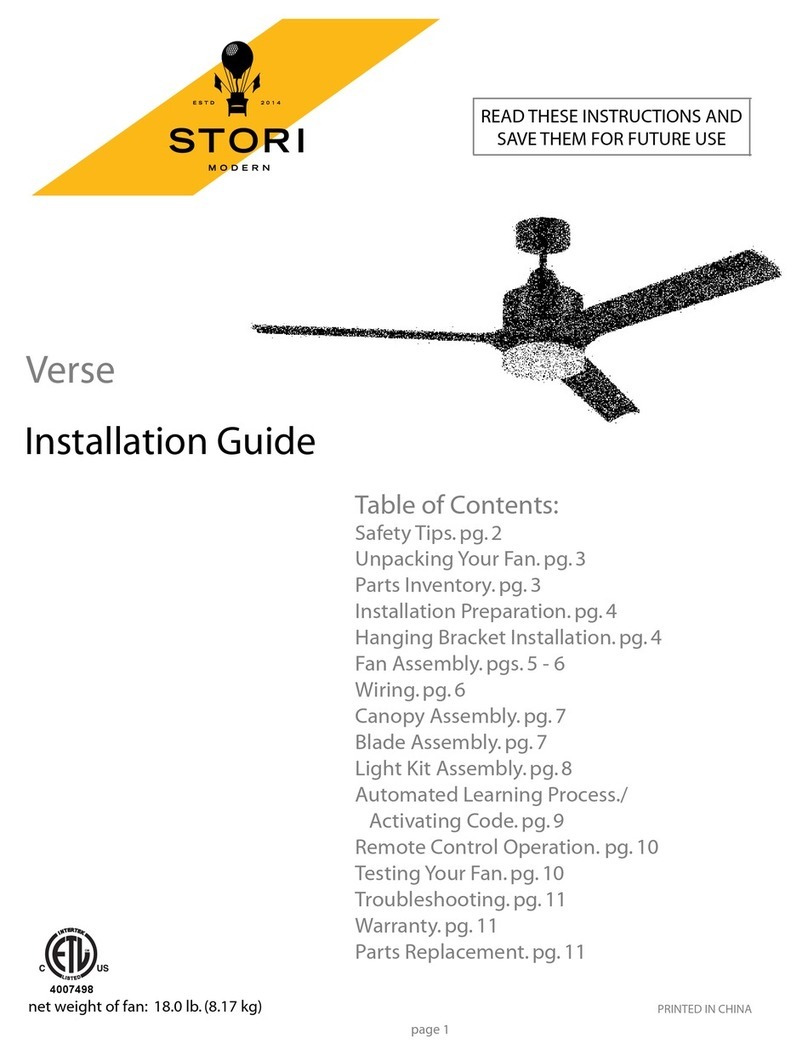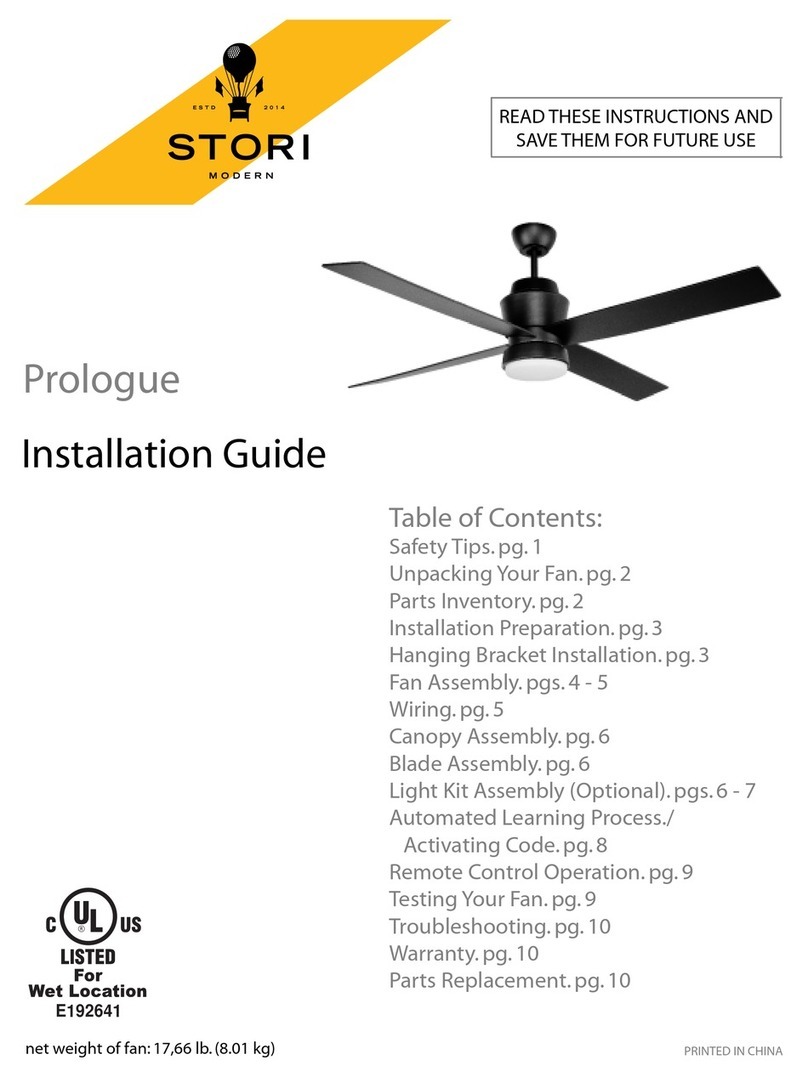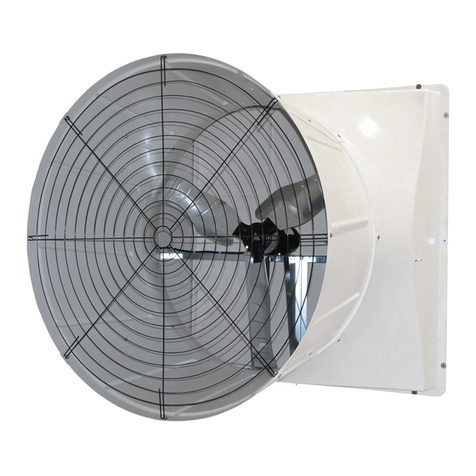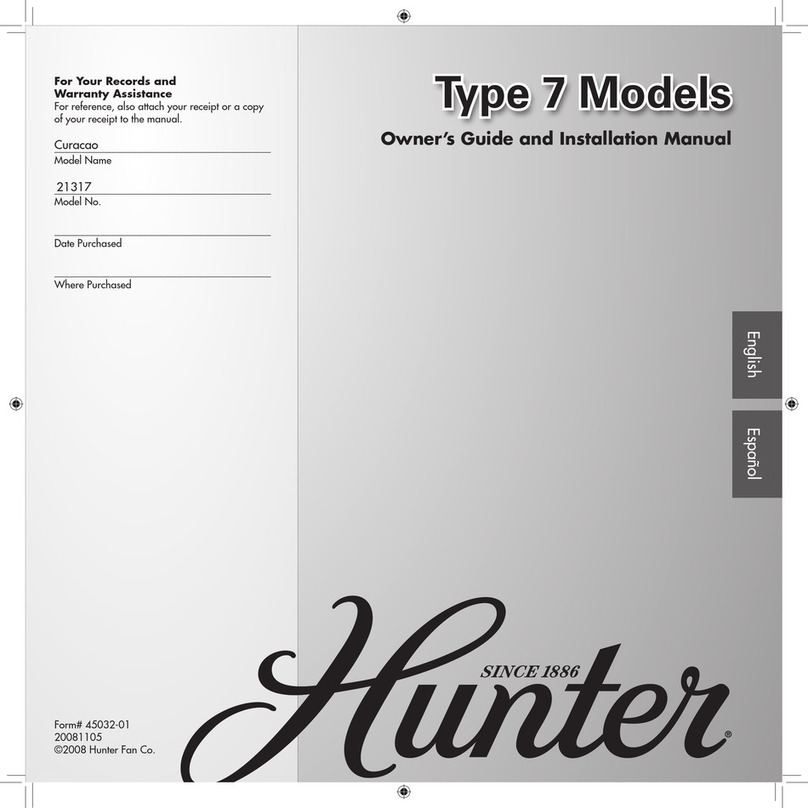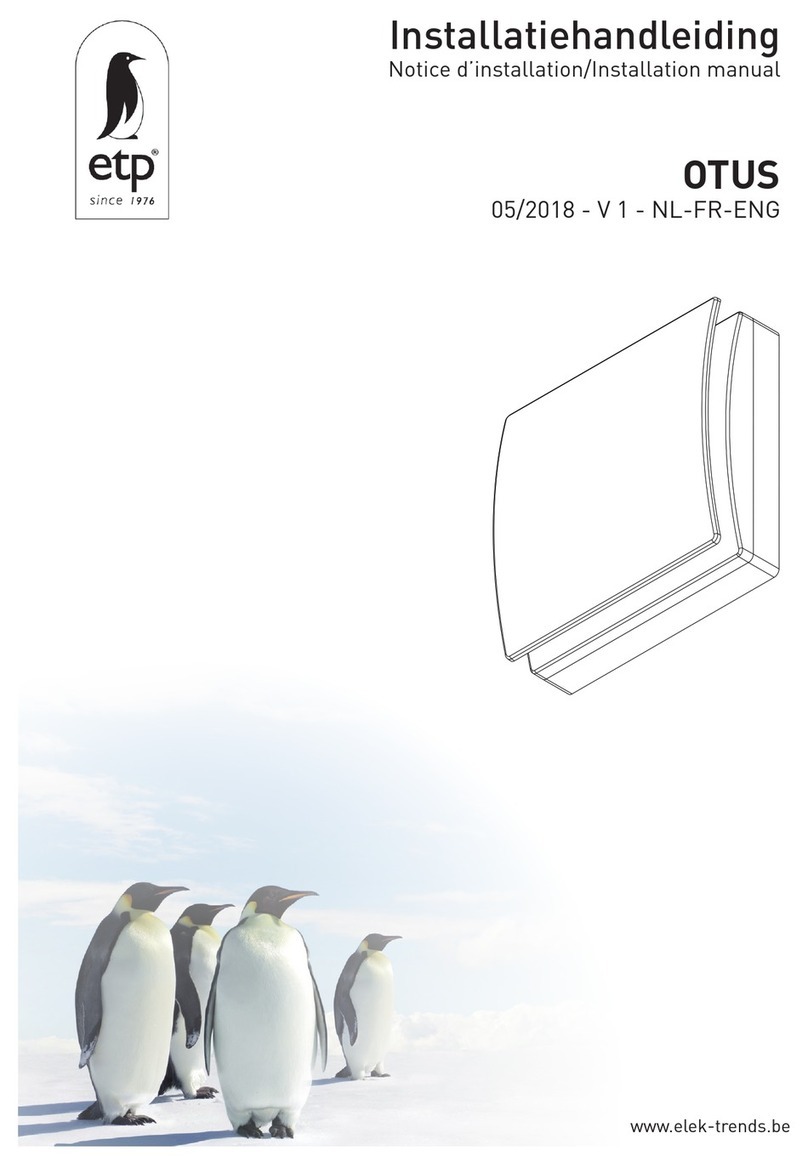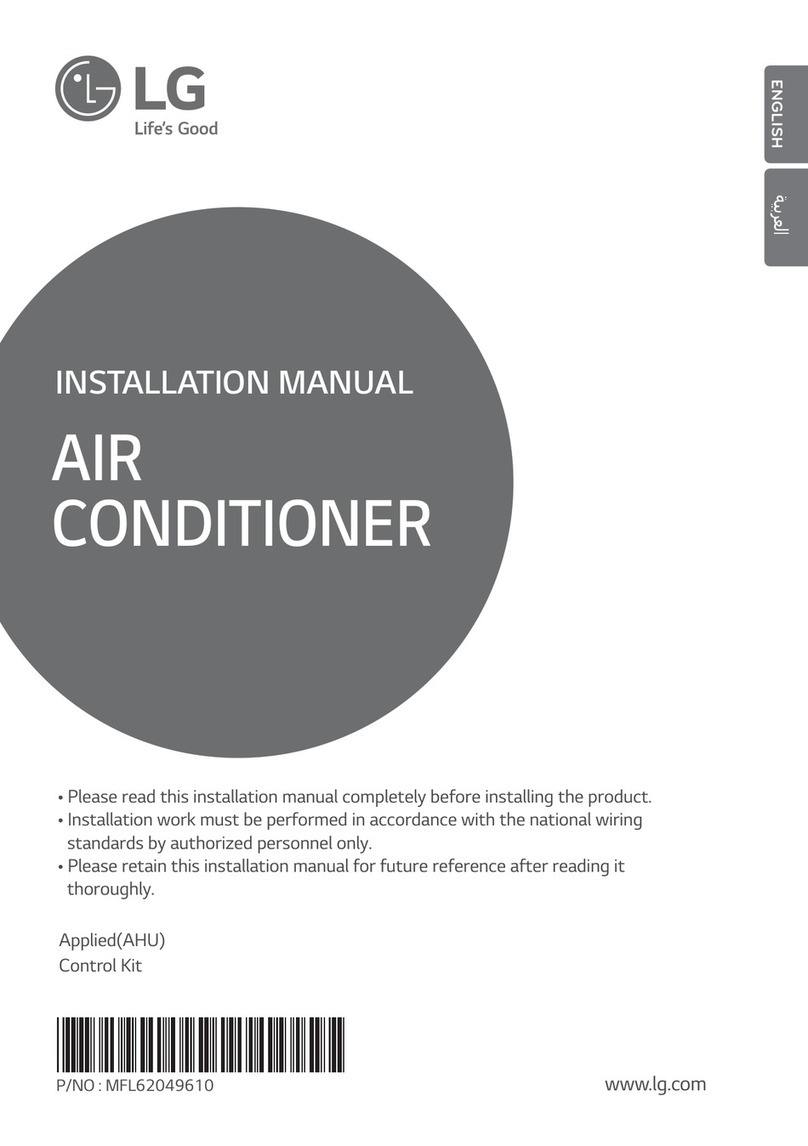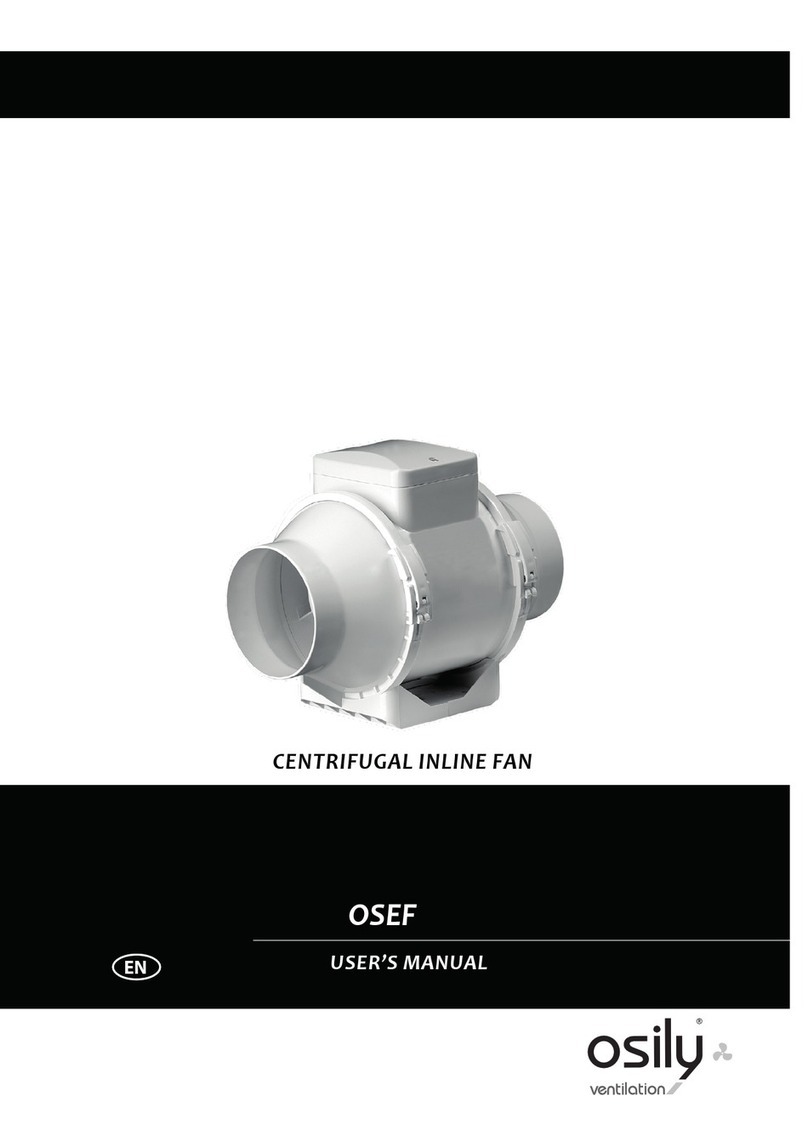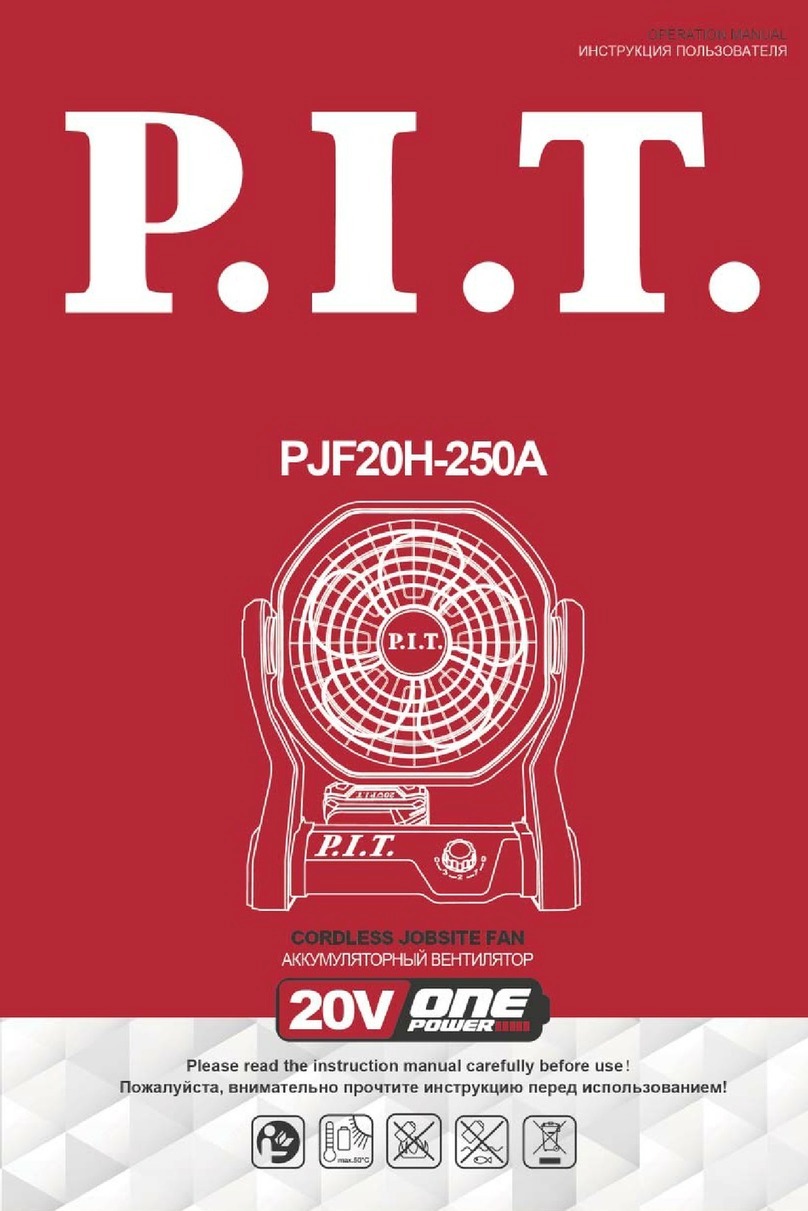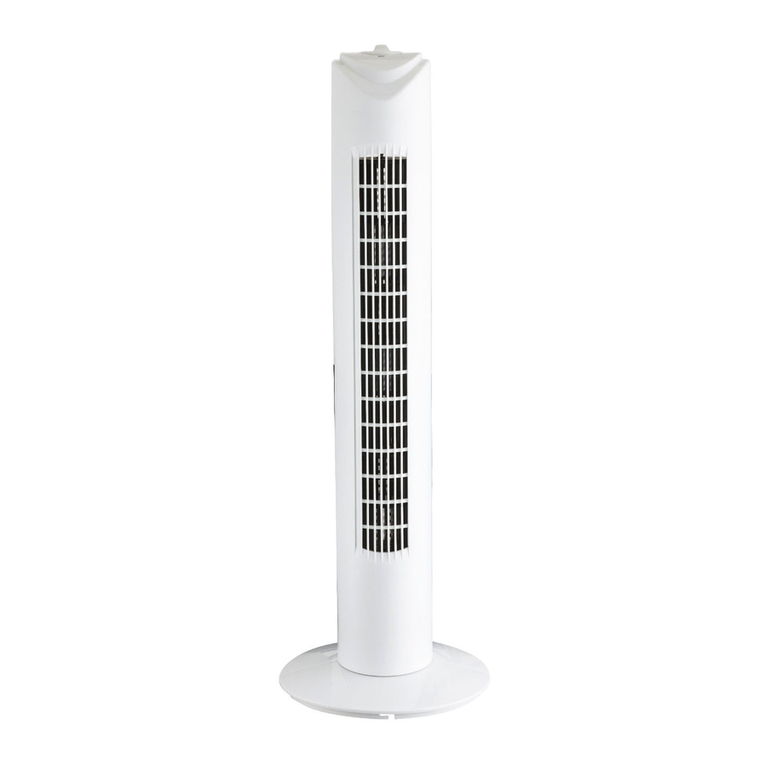stori Epilogue User manual

net weight of fan: 16.87 lb. (7.65 kg) PRINTED IN CHINA
READ THESE INSTRUCTIONS AND
SAVE THEM FOR FUTURE USE
Table of Contents:
Safety Tips. pg. 1
Unpacking Your Fan. pg. 2
Parts Inventory. pg. 2
Installation Preparation. pg. 3
Hanging Bracket Installation. pg. 3
Fan Assembly. pgs. 4 - 5
Wiring. pg. 5
Canopy Assembly. pg. 6
Blade Assembly. pg. 6
Final Fan Assembly. pg. 6
Automated Learning Process./
Activating Code. pg. 7
Remote Control Operation. pg. 8
Testing Your Fan. pg. 8
Troubleshooting. pg. 9
Parts Replacement. pg. 9
Warranty. pg. 9
Installation Guide
E192641
Epilogue

SAFETY TIPS.
page 1
WARNING: To reduce the risk of electrical shock, turn off the electricity to the fan at the main fuse box or circuit
panel before you begin the fan installation or before servicing the fan or installing accessories.
1. READ ALL INSTRUCTIONS AND SAFETY INFORMATION CAREFULLY BEFORE INSTALLING YOUR FAN
AND SAVE THESE INSTRUCTIONS.
CAUTION: To avoid personal injury, the use of gloves may be necessary while handling fan parts with sharp
edges.
2. Make sure all electrical connections comply with Local Codes or Ordinances, the National Electrical Code,
and ANSI/NFPA 70-1999. If you are unfamiliar with electrical wiring or if the house/building wires are
different colors than those referred to in the instructions, please use a qualified electrician.
3. Make sure you have a location selected for your fan that allows clear space for the blades to rotate, and at
least seven (7) feet (2.13 meters) of clearance between the floor and the fan blade tips. The fan should
be mounted so that the tips of the blades are at least thirty (30) inches (76 centimeters) from walls or
other upright structures.
4. The outlet box and ceiling support joist used must be securely mounted and capable of supporting at
least 35 pounds (16 kilograms). The outlet box must be supported directly by the building structure.
Use only CUL (Canada) or UL (USA) listed outlet boxes marked "FOR FAN SUPPORT."
WARNING: To reduce the risk of fire, electrical shock, or personal injury, mount to the outlet box marked
"Acceptable for Fan Support of 22.68 kg (50 lbs) or less," and use the mounting screws provided with the outlet
box. Most outlet boxes commonly used for the support of lighting fixtures are not acceptable for fan support
and may need to be replaced. Consult a qualified electrician if in doubt.
WARNING: To reduce the risk of fire, electrical shock, or personal injury, wire connectors provided with this fan
are designed to accept only one 12 gauge house wire and two lead wires from the fan.If your house wire is
larger than 12 gauge or there is more than one house wire to connect to the corresponding fan lead wires,
consult an electrician for the proper size wire connectors to use.
WARNING: If using this fan in a WET location,this fan must be connected to a supply circuit that is protected by
a Ground Fault Circuit Interrupter (GFCI) to reduce the risk of personal injury, electrical shock or death.
5. Electrical diagrams are for reference only. [Note:This fan is NOT adaptable for use with light kit.]
6. After installation is complete, check that all connections are absolutely secure.
7. After making electrical connections, spliced conductors should be turned upward and pushed carefully up
into the outlet box. The wires should be spread apart with the grounded conductor and the
equipment-grounding conductor on opposite sides of the outlet box.
WARNING: To reduce the risk of electrical shock or fire, do not use this fan with any solid state speed control
device or control fan speed with a full range dimmer switch. [Using a full range dimmer switch to control fan
speed will cause a loud humming noise from fan.]
8. Do not operate the reverse switch until fan has come to a complete stop.
9. Do not insert anything between the fan blades while they are rotating.
WARNING: To reduce the risk of personal injury, do not bend the blade arms during assembly or after
installation. Do not insert objects into the path of the blades.
WARNING: To avoid personal injury or damage to the fan and other items,be cautious when working around or
cleaning the fan.
10. Do not use water or detergents when cleaning the fan or fan blades.A dry dust cloth or lightly dampened
cloth will be suitable for most cleaning.
WARNING: To reduce the risk of personal injury, use only parts provided with this fan. The use of parts OTHER
than those provided with this fan will void the warranty.
WARNING: This fan MUST be installed with the safety cable provided with the fan.Failure to use the safety cable
provided may result in personal injury, damage to the fan or damage to other property.
NOTE: The important safety precautions and instructions appearing in the manual are not meant to cover all
possible conditions and situations that may occur. It must be understood that common sense and caution are
necessary factors in the installation and operation of this fan.

2. Parts Inventory.
a. hanging bracket. 1 piece
b.canopy. 1 piece
c. yoke cover. 1 piece
d.downrod and hanging ball.1 piece
e. remote control receiver. 1 piece
f. remote control transmitter. 1 piece
g. weatherproof hanging ball cover
(in hardware pack).1 piece
h. canopy cover (in hardware pack). 1 piece
i.motor housing. 1 piece
j.fitter plate. 1 piece
k.metal cover. 1 piece
l. blade. 4 pieces
m. hardware packs
page 2
1. Unpacking Your Fan.
IMPORTANT REMINDER: You must
use the parts provided with this fan for
proper installation and safety.
b
d
c
a
l
i
f
e
w/ remote
h
m
k
j
g
Carefully open the packaging.Remove items from
Styrofoam inserts. Remove motor housing and
place on carpet or Styrofoam to avoid damage to
finish. *The four motor stabilization pieces may be
dicarded at this time.Do not discard fan carton or
Styrofoam inserts should this fan need to be
returned for repairs.
Check against parts inventory that all parts have
been included.
*

3. Installation Preparation.
4. Hanging Bracket Installation
page 3
To prevent personal injury and damage, ensure
that the hanging location allows the blades a
clearance of 7ft. (2.13m) from the floor and 30in.
(76cm) from any wall or obstruction.
This fan is suitable for room sizes up to 400 square
feet (37.2 square meters).
This fan can be mounted with a downrod
on a regular (no-slope) or vaulted ceiling. The
hanging length can be extended by purchasing a
longer downrod (0.5in./1.27cm diameter). Other
installation, such as flushmount, is not available
for this fan.
Installation requires these tools:
Phillips screwdriver, flathead screwdriver,
adjustable pliers or wrench, stepladder, wire
cutters,and rated electrical tape.
Vaulted ceiling
angle is not to
exceed 25 degrees.
downrod
installation flushmount
installation
4. Hanging Bracket Installation.
ON
OFF
ON
OFF
Turn off circuit breakers to current fixture from
breaker panel and be sure operating light switch is
turned to the OFF position.
WARNING: Failure to disconnect power supply prior to
installation may result in serious injury.
Remove existing fixture.
WARNING: When using an existing outlet box, be sure
the outlet box is securely attached to the building
structure and can support the full weight of the fan.
Ensure outlet box is clearly marked "Suitable for Fan
Support." If not, it must be replaced with an approved
outlet box. Failure to do so can result in serious injury.
CAUTION: Be sure outlet box is properly grounded
and that a ground (GREEN or bare) wire is present.
Install hanging bracket to outlet box,using original
screws,spring washers and flat washers provided
with new or original outlet box.* If installing on a
vaulted ceiling,face opening of hanging bracket
towards high point of ceiling.Arrange electrical
wiring around the back of the hanging bracket and
away from the bracket opening.
*Note: It is very important that you use the proper
hardware when installing the hanging bracket as this
will support the fan.
blade edge
7 feet
(2.13m) (76cm)
30
inches
12 ft. - 20 ft.
12 ft. - 20 ft.
(3.66m - 6.1m)
(3.66m - 6.1m)
hanging bracket
spring washers
outlet box screws
flat washers

page 4
5. Fan Assembly.
If you wish to extend the hanging length of your fan,
you must remove the hanging ball from the downrod
provided to use with an extended downrod (sold
separately). [If you wish to use the downrod provided,
please proceed to instructions following the dotted line
below.]
To remove hanging ball, loosen set screw on hanging
ball, lower hanging ball and remove stop pin. Slide
hanging ball off the original downrod, A, and slide it
down the longer downrod, B (the top of the downrod
should be noted as having a set screw hole; use this
hole when setting the set screw). Insert stop pin into
top of extended downrod and raise hanging ball.Be
sure stop pin aligns with slots on the inside of the
hanging ball.Tighten set screw securely.
WARNING: Failure to tighten set screw (on hanging
ball) completely could result in the fan becoming loose
and possibly falling.
Tip: To prepare for threading electrical wires through
downrod, apply a small piece of electrical tape to the
ends of the electrical wires--this will keep the wires
together when threading them through the downrod.
Loosen yoke set screws and nut at top of motor
housing.Remove pin and clip from motor housing
yoke.
Locate canopy cover in one of the hardware packs.
Slide downrod through canopy, canopy cover and yoke
cover. (Note: Canopy cover must be turned with shiny
side toward motor housing.)
Thread electrical wires and safety cable through
downrod and pull extra wire slack from the upper end
of the downrod.
Place downrod into the motor housing yoke and
re-insert pin and clip that were previously removed.
Tighten yoke set screws and nut securely. Lower yoke
cover to motor housing.
Remove electrical tape from electrical wires and thread
one wire through each hole in the weatherproof
hanging ball cover and then thread the safety cable
through the same hole as the ground wire as shown.
Pull weatherproof hanging ball cover down securely
over hanging ball (on downrod).
["Fan Assembly" continued on next page.]
NOTE:The important safety precautions and instructions
appearing in the manual are not meant to cover all possible
conditions and situations that may occur. It must be
understood that common sense and caution are necessary
factors in the installation and operation of this fan.
canopy
motor
housing
yoke cover
canopy
cover
set screw
hanging ball
stop pin
A
B
set screw hole
downrod
safety cable
hanging ball
weatherproof
hanging ball
cover
electrical
wiring
green/ground
wire

page 5
5. Fan Assembly. (cont.)
With the hanging bracket secured to the outlet box and
able to support the fan, you are now ready to hang your
fan. Grab the fan firmly with two hands. Slide downrod
through opening in hanging bracket and let hanging ball
rest on the hanging bracket.Turn the hanging ball slot
until it lines up with the hanging bracket tab.
WARNING: Failure to align slot in hanging ball with tab in
hanging bracket may result in serious injury or death.
Tip: Seek the help of another person to hold the
stepladder in place and to help lift the fan up to you once
you are set on the ladder.
Find a secure attachment point (wood ceiling joist highly
recommended) and secure safety cable. It will be
necessary to use a heavy duty wood screw, washer and
lock washer (not supplied) with the safety cable loop. If
necessary, adjust the loop at the end of the safety cable.
The loop at the end of the safety cable should just fit over
the threads on the wood screw. Test safety cable by pulling
on loose end of cable with pliers. If the safety cable slips, the
loop must be adjusted tighter. Extra cable slack can be left
in ceiling area.
6.Wiring.
Modifications not approved by the party responsible for compliance
could void the user's authority to operate the equipment.
*NOTE:This equipment has been tested and found to comply with the limits for a Class B
digital device,pursuant to Part 15 of the FCC Rules.These limits are designed to provide
reasonable protection against harmful interference in a residential installation.This
equipment generates,uses and can radiate radio frequency energy and,if not installed and
used in accordance with the instructions,may cause harmful interference to radio
communications.However, there is no guarantee that interference will not occur in a
particular installation. If this equipment does cause harmful interference to radio or television
reception,which can be determined by turning the equipment off and on, the user is
encouraged to try to correct the interference by one or more of the following measures:
* Reorient or relocate the receiving antenna.
* Increase the separation between the equipment and receiver.
* Connect the equipment into an outlet on a circuit different from that to which the
receiver is connected.
Consult the dealer or an experienced radio/TV technician for help.
WARNING:Turn off circuit breakers to current fixture
from breaker panel and be sure switch is turned to the
OFF position.
CAUTION: Be sure outlet box is properly grounded and
that a ground wire (GREEN or Bare) is present.
Make sure all electrical connections comply with Local
Codes or Ordinances and the National Electrical Code. If
you are unfamiliar with electrical wiring or if the
house/building wires are different colors than those
referred to in the diagram to the right, please use a
qualified electrician.
Note: Excess lead wire length from the fan can be cut to
the desired length and then stripped.
WARNING: If using this fan in a WET location, this fan
must be connected to a supply circuit that is protected
by a Ground Fault Circuit Interrupter (GFCI) to reduce
the risk of personal injury, electrical shock or death.
When downrod is secured in place on the hanging
bracket, wire the RECEIVER with wire connectors
provided as shown in diagram at right.
CAUTION: Do NOT remove the cap from the blue
wire on the receiver. The blue wire will NOT be
connected.
Tip:While you are wiring, keep in mind that wires must
not obstruct receiver from sliding into hanging bracket.
* Wrap each wire connector separately with electrical
tape as an extra safety measure.
Gently insert receiver (flat side up) into hanging bracket
and carefully push wires and taped wire connectors into
outlet box.Let antenna rest outside of hanging bracket.
hanging ball slot
hanging bracket tab
motor housing
safety
cable
safety cable loop
wood ceiling joist
wood screw
and washer
ground (green
or bare)
white supply wire
black supply wire
black
black
white
blue
white
from receiver
black
AC IN L
AC IN N
white
white
ground (green
or bare)
from fan
from receiver
antenna
from ceiling
receiver
black
*

page 6
8. Blade Assembly.
Time Saver:Washers for blade screws can be set
on each blade screw prior to installing blades.
Locate 12 blade attachment screws and washers
in hardware pack.Observe label on blade
indicating THIS SIDE UP and then slide blade
through one of the narrow, rectangular openings
on motor housing. Make sure to align holes in
blade with holes in blade arm, which is located
on the INSIDE of the motor housing and can be
seen from the UNDERSIDE of the motor
housing--refer to drawing at right.Insert 3 blade
attachment screws (along with washers) with
fingers first and then tighten screws securely
with a Phillips screwdriver. Repeat procedure for
each remaining blade.
NOTE:Tighten blade attachment screws twice a
year.
9. Final Fan Assembly.
Remove 1 screw from motor plate (on
underside of motor) and partially loosen the
other 2 screws.Align slotted holes in fitter plate
with loosened screws in motor plate.Twist fitter
plate to lock.Re-insert screw that was just
removed and tighten all 3 screws securely.
Place metal cover over fitter plate, aligning hole
in center of metal cover with threaded rod in
fitter plate. Tighten metal cover securely.
motor plate
7. Canopy Assembly.
Locate 2 screws on underside of hanging bracket
and remove screw closest to the open end of the
hanging bracket. Partially loosen the other screw.
Lift canopy to hanging bracket. Place rounded
part of slotted hole in canopy over loosened screw
in hanging bracket and push up.Twist canopy to
lock. Re-insert screw that was removed and then
tighten both screws securely.
Slide canopy cover up to canopy, aligning
rounded part of slotted holes in canopy cover
with screwheads in bottom of canopy.Turn
canopy cover to the right (clockwise) until it stops.
*Remember that antenna for remote control
receiver must rest outside of hanging bracket.
canopy cover
screw
canopy
hanging bracket
screw
antenna
blade
motor housing
blade attachment
screws and washers
blade arm
(inside motor
housing)
motor
housing
threaded
rod
fitter plate
metal cover

page 7
(backside)
remote control
transmitter
battery
10. Automated Learning Process./
Activating Code.
CAUTION:The remote control transmitter can be
programmed to multiple receivers or fans.If this is
not desired, turn wall switch off to any other
programmable receiver or fan.
Remove battery cover from backside of remote
control transmitter.
Install one 3-volt battery (size CR2032, included)
in transmitter. Replace battery cover on
transmitter.
IMPORTANT:To prevent damage to remote
control transmitter, remove the battery if not
used for long periods.Store the transmitter
away from excess heat or humidity.
WARNING: Choking Hazard - Small parts. Keep
battery away from children.
WARNING:To avoid personal injury, DO NOT
charge or heat battery. DO NOT break battery
apart or cause battery to become deformed.
WARNING: BATTERY DISPOSAL INFORMATION,
Place insulating tape around battery before
disposing of the battery. Do not dispose of this
battery along with other lithium batteries nor
place beside other metal objects in the trash.
Failure to follow these guidelines may cause the
battery to burst or catch fire.
Restore electrical power.Within 30 seconds of
restoring electrical power, press the "Off"
button ( ), located on the front of the
transmitter, for 5 seconds (or fan blades begin
to turn).Test the fan functions to confirm the
learning process is complete--see Section 12.
battery
cover
fan button
transmitter
(front)

page 8
button
button
button
button
It is recommended that you test fan before
finalizing installation. Test fan speeds with the
different fan speed buttons on the remote
control transmitter. (For more detailed
information on using remote control, see
Section 11 above.)
If the transmitter operates all of the functions
of the fan, battery has been installed correctly.
If fan does not function, please refer to
"Troubleshooting" section to solve any issues
before contacting Customer Service.
Turn fan completely off before moving the
reverse switch (located on top of motor
housing.) Set reverse switch to recirculate air
depending on the season:
- LEFT position in summer (diagram 1)
- RIGHT position in winter (diagram 2)
A ceiling fan will allow you to raise your
thermostat setting in summer and lower your
thermostat setting in winter without feeling a
difference in your comfort.
Important: Reverse switch must be set either
completely to the LEFT or completely to the
RIGHT for fan to function. If the reverse switch
is set in the middle position (diagram 3), fan
will not operate.
NOTE: Do NOT remove weatherproof cover
from reverse switch.
12.Testing Your Fan.
11. Remote Control Operation.
to control fan speed
to control light brightness
- This button not applicable for this fan -
reverse switch
motor
housing
diagram 1 diagram 2 diagram 3
- turns fan to HIGH speed
- turns fan to MEDIUM speed
- turns fan to LOW speed
- turns fan OFF
weatherproof cover
for reverse switch

page 9
Troubleshooting. Warranty.
WARNING: Failure to disconnect power supply
prior to troubleshooting any wiring issues may
result in serious injury.
STORIMODERN LIFETIME LIMITED WARRANTY:
STORIMODERN warrants this fan to the original household
purchaser for indoor/outdoor use under the following
provisions:
1-YEAR WARRANTY: STORIMODERN will replace or repair
any fan which has faulty performance due to a defect in
material or workmanship.Contact StoriModern Customer
Service at 1-844-557-8674 to arrange for return of fan.
Return fan, shipping prepaid,to StoriModern. We will
repair or ship you a replacement fan, and we will pay the
return shipping cost.
5-YEAR WARRANTY: STORIMODERN will repair or replace, at
no charge to the original purchaser, any fan motor that fails
to operate satisfactorily when failure results from normal
use.
RETURN FAN MOTOR ONLY, shipping prepaid,to
StoriModern.We will repair or ship purchaser a
replacement motor and StoriModern will pay the return
shipping cost.
6-YEAR to LIFETIME LIMITED WARRANTY: STORIMODERN
will repair the fan, at no charge for labor only to the
original purchaser, if the fan motor fails to operate
satisfactorily when failure results from normal use.Parts
used in the repair will be billed to the purchaser at
prevailing prices at time of repair.
The purchaser shall be responsible for all costs incurred
in the removal, reinstallation and shipping of the product
for repairs.
This warranty does not apply when damage from
mechanical, physical, electrical or water abuse results in
causing the malfunction. Deterioration of finishes or other
parts due to time or exposure to salt air is specifically
exempted under this warranty.
Neither StoriModern nor the manufacturer will assume
any liability resulting from improper installation or use of
this product. In no case shall the company be liable for any
consequential damages for breach of this, or any other
warranty expressed or implied whatsoever.This limitation
as to consequential damages shall not apply in states
where prohibited.
Problem: Fan fails to operate.
Solutions:
1. Check wall switch to fan.
2.Verify that reverse switch is set completely in
either direction.
3.Verify that receiver is wired properly.
4. Check to be sure fan is wired properly.
5. Learning process between fan and remote
control transmitter may not have been successful
and code was not activated.Turn off power,
remove battery cover from back of transmitter and
repeat instructions in last paragraph of Section 10
(page 7).
Problem: Fan fails to operate with remote control.
Solutions:
1. Check battery power to remote control.
2. Learning process between fan and remote
control transmitter may not have been successful
and code was not activated.Turn off power,
remove battery cover from back of transmitter and
repeat instructions in last paragraph of Section 10
(page 7).
Problem: Fan wobbles.
Solutions:
1. Use the balancing kit in one of the hardware
packs. If no blade balancing kit is provided, please
call Customer Support, at 1-844-557-8674, to request
one.
2. Check to be sure set screw(s) on motor housing
yoke is (are) tightened securely.
3. Check to be sure set screw on hanging ball is
tightened securely.
KHLI1705
Parts Replacement.
For parts and information, please refer to
"Parts Inventory" on page 2.
Customer Support:
844-557-8674
www.STORIMODERN.com

IMPRESO EN CHINA
Índice de materias:
Sugerencias de seguridad. Pág. 1
Desempaquetado del ventilador. Pág. 2
Inventario de piezas. Pág. 2
Preparación para la instalación.Pág.3
Instalación del soporte de montaje.Pág.3
Ensamblaje del ventilador. Págs. 4 - 5
Instalación eléctrica. Pág. 5
Colocación de la cubierta decorativa.Pág.6
Colocación de las aspas. Pág. 6
Instalación final del ventilador. Pág. 6
Proceso de aprendizaje automático./
El activar el código. Pág. 7
Funcionamiento del control remoto. Pág. 8
Verificación del funcionamiento del
ventilador. Pág. 8
Localización de fallas. Pág. 9
Piezas de repuesto. Pág. 9
Garantía. Pág. 9
LEER ESTAS INSTRUCCIONES Y
GUARDARLAS PARA UTILIZACION FUTURA
Guía de instalación
peso neto del ventilador: 7,65 kg (16,87 lb)
REGISTRADO PARA
LUGAR MOJADO
E192641
Epilogue

página 1
SUGERENCIAS DE SEGURIDAD.
ADVERTENCIA: Para evitar la posibilidad de una descarga eléctrica, desconectar la corriente en la caja de fusibles principal o el
interruptor protector antes de iniciar la instalación del ventilador o antes de repararlo o instalar accesorios.
1. LEER TODAS LAS INSTRUCCIONES E INFORMACIÓN DE SEGURIDAD CUIDADOSAMENTE ANTES DE INSTALAR SU
VENTILADOR Y GUARDAR ESTAS INSTRUCCIONES.
PRECAUCIÓN: Para reducir el riesgo de daño corporal, es posible que sea necesario usar guantes al manejar las piezas del
ventilador que tengan bordes afilados.
2. Asegurarse de que todas las conexiones eléctricas cumplan con los Códigos o las Ordenanzas Locales,el Código Nacional
Eléctrico y ANSI/NFPA 70-1999. Si usted no está familiarizado con el alambrado eléctrico o los cables de la casa/el edificio
son de colores diferentes a los cuales se refieren en las instrucciones, favor de buscar un electricista calificado.
3. Asegurarse de que haya localizado una ubicación para su ventilador que permite el espacio necesario para la rotación de las
aspas,y por lo menos 2,13 metros (7 pies) de espacio libre entre el piso y las puntas de las aspas. Debe instalar el
ventilador para que las puntas de las aspas queden a una distancia de por lo menos 76 centímetros (30 pulgadas) de las
paredes y otras estructuras verticales.
4. La caja de salida eléctrica debe estar bien sujetada a la viga de soporte del techo y deben ser capaces de sostener por lo
menos 16 kilogramos (35 libras). La caja de salida debe tener apoyo directo de la estructura del edificio. Sólo usar cajas
de salida registradas con CUL (Canadá) o UL (EEUU) que indican que "sirven para ventilador" ("FOR FAN SUPPORT" en
inglés).
ADVERTENCIA: Para reducir el riesgo de incendio, descarga eléctrica o daño corporal, instalar en la caja de salida marcada
"Aceptable para sostener ventilador de 15,9 kg (35 lb) o menos" ["Acceptable for Fan Support of 15.9 kg (35 lb) or less"] y utilizar
los tornillos proporcionados con la caja de salida. La mayoría de las cajas de salida que normalmente se usan para sostener los
aparatos de alumbrado no siempre son apropiadas para sostener ventiladores y es posible que las tenga que reemplazar. En caso
de duda, consultar con un electricista calificado.
ADVERTENCIA: Para reducir el riesgo de incendio, descarga eléctrica o daño corporal, los conectores para cable provistos con
este ventilador son diseñados para aceptar sólo un cable de calibre 12 de la casa y dos cables principales del ventilador. Si el
calibre del cable de la casa es superior al 12 o hay más de un cable de la casa para conectar a los cables principales del ventilador
al cual corresponda cada uno, consultar con un electricista para informarse sobre el tamaño correcto de conectores para cable
que se debe usar.
ADVERTENCIA: Si se va a utilizar este ventilador en un lugar MOJADO hay que conectar el ventilador a un circuito de
alimentación que esté protegido por un Interruptor de Circuito de Falla de Tierra (GFCI, por sus siglas en inglés) para reducir el
riesgo de daño corporal,descarga eléctrica o la muerte.
5. Los diagramas eléctricos son únicamente para referencia.[Nota: Este ventilador NO es adaptable para uso con juego de luz.]
6. Después de haber terminado la instalación, asegurarse de que todas las conexiones estén totalmente seguras.
7. Después de haber terminado todas las conexiones eléctricas,los conductores empalmados deben ser volteados para arriba
y colocados cuidadosamente dentro de la caja de salida. Los alambres se deben de separar con el conductor a tierra a un
lado y el conductor a tierra del equipo al lado opuesto.
ADVERTENCIA: Para reducir el riesgo de incendio o una descarga eléctrica, no usar el ventilador con ningún control de velocidad
de estado sólido ni controlar la velocidad del ventilador con un interruptor con reductor de luz de gama completa. [El usar un
interruptor con reductor de luz de gama completa para controlar la velocidad del ventilador causará un zumbido recio del
ventilador.]
8. No utilizar el interruptor de reversa hasta que el ventilador se haya parado completamente.
9. No insertar ningún objeto entre las aspas mientras estén rotando.
ADVERTENCIA: Para reducir el riesgo de daño corporal, no insertar objetos entre las aspas mientras estén rotando.
ADVERTENCIA: Para reducir el riesgo de daño corporal o algún daño al ventilador, tener cuidado al estar trabajando alrededor
del ventilador o limpiándolo.
10. No utilizar agua ni detergentes para limpiar el ventilador ni las aspas. Usar un trapo seco o ligeramente húmedo para su
limpieza general.
ADVERTENCIA: Para reducir el riesgo de daño corporal, usar sólo las piezas provistas con este ventilador. Al usar piezas
DISTINTAS a las provistas con este ventilador se invalidará la garantía.
ADVERTENCIA:Este ventilador DEBE instalarse con el cable de seguridad provisto. Si no se utiliza el cable de seguridad provisto,
se pueden producir lesiones personales,daños al ventilador o a otras propiedades.
NOTA: No se debe concluir que las precauciones de seguridad importantes e instrucciones en este manual van a abarcar todas las
condiciones y situaciones posibles que puedan ocurrir. Se debe entender que el sentido común y la precaución son factores
necesarios en la instalación y la operación de este ventilador.

2. Inventario de piezas.
a. soporte de montaje. 1 unidad
b. cubierta decorativa. 1 unidad
c.cubierta del cuello. 1 unidad
d. tubo y bola que sirve para colgar. 1 unidad
e.receptor del control remoto 1 unidad
f.transmisor del control remoto 1 unidad
g. cubierta a prueba de la intemperie para
la bola que sirve para colgar (en paquete
de artículos de ferretería). 1 unidad
h.tapa de la cubierta decorativa (en paquete
de artículos de ferretería). 1 unidad
i.bastidor del motor. 1 unidad
j.placa de conexión. 1 unidad
k. cubierta de metal. 1 unidad
l. aspa. 4 unidades
m. paquetes de artículos de ferretería
página 2
1. Desempaquetado del ventilador.
RECORDATORIO IMPORTANTE: Se tienen
que utilizar las piezas provistas con este ventilador
para una instalación adecuada y su seguridad.
Abrir el empaque cuidadosamente.Sacar los
artículos del embalaje.Sacar el motor y ponerlo en
una alfombra o en el embalaje para evitar rayar el
acabado. *Se pueden desechar las piezas de
estabilización del motor en este momento. Guardar
la caja de cartón o el empaquetamiento original en
caso de que tenga que mandar el ventilador para
alguna reparación.
Comprobar las piezas del ventilador con el inventario
de piezas y verificar que se incluyeron todas.
b
d
c
a
l
i
f
e
con el
control
h
m
k
j
g
*

página 3
3. Preparación para la instalación.
4. Instalación del soporte de montaje.
Apagar los cortacircuitos en el panel de electricidad que
suplen corriente a la caja de salida y asegurarse de que el
interruptor de luz esté APAGADO.
ADVERTENCIA: El no desconectar el suministro de fuerza
antes de la instalación puede tener por resultado lesiones
graves.
Quitar el aparato existente.
ADVERTENCIA: Si utiliza una caja de salida existente,
asegurarse de que la caja de salida esté firmemente
conectada a la estructura del edificio y que sea capaz de
sostener el peso total del ventilador. Asegurarse de que la
caja de salida indique claramente que "Sirve para
ventilador" (FOR FAN SUPPORT); si no, se debe reemplazar
con una caja de salida aprobada. El no hacer el cambio si es
necesario puede resultar en lesiones graves.
PRECAUCIÓN: Asegurarse de que la caja de salida esté
conectada a tierra correctamente y que haya un conductor
a tierra (VERDE o pelado).
Instalar el soporte de montaje utilizando los tornillos
originales, las arandelas de resorte y las arandelas planas
de su nueva o existente caja de salida.*Si hace la
instalación en un techo abovedado, colocar el soporte
de montaje con la abertura dirigida hacia la parte alta del
techo. Arreglar el alambrado eléctrico (los cables) en la
parte de atrás del soporte y lejos de la abertura del
soporte.
*Nota: Es muy importante usar los artículos de ferretería
correctos al instalar el soporte de montaje puesto que sirve
para sostener el ventilador.
El ángulo de inclina-
ción de un techo
abovedado no debe
exceder los 25 grados.
instalación
con tubo instalación al ras
con el techo
Se necesitan las herramientas siguientes para la
instalación:
Destornillador de estrella Phillips,destornillador de
paleta (plano), alicates ajustables o llave de tuercas,
escalera de tijera, cortaalambres y cinta aisladora.
Para prevenir daño corporal y otros daños,estar seguro
de que el lugar en donde va a colgar el ventilador le
permite un espacio libre de 2,13 m (7 pies) entre las
puntas de las aspas y el piso y 76 cm (30 pulg.) entre las
aspas y cualquier pared u otra obstrucción.
Este ventilador es adecuado para habitaciones hasta
37,2 metros cuadrados (400 pies cuadrados).
Se puede colgar este ventilador con tubo en un
techo regular (sin inclinación) o abovedado. La
longitud colgante se puede extender comprando un
tubo más largo (con diámetro de 1,27 cm/0,5 pulg.).
No hay ningún otro tipo de instalación,como al ras
con el techo, disponible para este ventilador.
borde
del aspa
2,13m
(7 pies)
76cm
(30
pulg.)
3,66m - 6,1m
3,66m - 6,1m
(12 pies - 20 pies)
(12 pies - 20 pies)
soporte de montaje
arandelas de resorte
tornillos de la
caja de salida
arandelas planas

página 4
5. Ensamblaje del ventilador.
NOTA: No se debe concluir que las precauciones de seguridad
importantes e instrucciones en este manual van a abarcar todas
las condiciones y situaciones posibles que puedan ocurrir. Se debe
entender que el sentido común y la precaución son factores
necesarios en la instalación y la operación de este ventilador.
agujero para
el tornillo
de fijación
tornillo
de fijación
bola que
sirve para
colgar
perno
de tope
A
B
Si usted desea extender la longitud colgante del
ventilador, usted tendrá que quitar la bola que sirve
para colgar del tubo provisto para usarla con un tubo
más largo (a la venta por separado). [Si desea utilizar el
tubo provisto, favor de pasar a las instrucciones después
de la línea punteada más abajo.]
Para quitar la bola que sirve para colgar, aflojar el tornillo
de fijación de la bola que sirve para colgar, bajar la bola
que sirve para colgar y sacar el perno de tope.Quitar la
bola que sirve para colgar del tubo original,A, y
deslizarla sobre el tubo más largo, B (la parte de arriba
del tubo debe tener el agujero para el tornillo de fijación
en ese extremo; usar ese agujero al colocar el tornillo de
fijación). Introducir el perno de tope en la parte de arriba
del tubo más largo y subir la bola que sirve para colgar.
Asegurarse de que el perno de tope se ponga en línea
con las ranuras dentro de la bola que sirve para colgar.
Apretar bien el tornillo de fijación.
ADVERTENCIA:Si no se aprieta bien el tornillo de fijación
(en la bola que sirve para colgar) es posible que se afloje el
ventilador y que se caiga.
Sugerencia: Para preparar los cables para pasarlos por el
tubo, poner un pedacito de cinta aisladora en la punta de
los cables--esto mantendrá los cables juntos al pasarlos
por el tubo.
Aflojar los tornillos de fijación del cuello y la tuerca en el
cuello del bastidor del motor. Quitar el perno y la clavija
del cuello del bastidor del motor.
Localizar la tapa de la cubierta decorativa en uno de los
paquetes de artículos de ferretería. Pasar el tubo por la
cubierta decorativa, la tapa de la cubierta decorativa y la
cubierta del cuello. (Nota: Se tiene que voltear la tapa de
la cubierta decorativa para que el lado brillante dé al
bastidor del motor.)
Pasar los cables del ventilador y el cable de seguridad a
través del tubo y con cuidado jalar el cableado en exceso
por la parte de arriba del tubo.
Colocar el tubo dentro del cuello del bastidor del motor y
volver a introducir el perno y la clavija que se quitaron
anteriormente. Apretar bien los tornillos de fijación del
cuello y la tuerca. Bajar la cubierta del cuello hasta el
bastidor del motor.
Quitar la cinta aisladora del cableado y pasar un cable
por cada agujero en la cubierta a prueba de la
intemperie para la bola que sirve para colgar y luego
pasar el cable de seguridad por el mismo agujero que el
que se usó para la toma de tierra/verde como se muestra.
Asegurar la cubierta a prueba de la intemperie a la bola
(en el tubo) que sirve para colgar.
[El "Ensamblaje del ventilador" continúa en la página
siguiente.]
cubierta
decorativa
bastidor
del motor
cubierta del cuello
tapa de la
cubierta
decorativa
tubo
cable de
seguridad
bola que sirve
para colgar
cubierta a prueba
de la intemperie
para la bola que
sirve para colgar
cableado
toma de tierra/
verde

página 5
5. Ensamblaje del ventilador. (cont.)
Ya que esté sujetado el soporte de montaje a la caja de salida y
capaz de apoyar el ventilador, usted está listo para colgar el
ventilador. Agarrar el ventilador firmemente con las dos manos.
Deslizar el tubo por la abertura del soporte de montaje y dejar que
se detenga la bola en el soporte de montaje. Girar la bola que sirve
para colgar hasta que la ranura de la bola se alinee con la parte
saliente del soporte de montaje.
ADVERTENCIA:El no alinear la ranura en la bola que sirve para
colgar con la parte saliente del soporte de montaje puede causar
lesiones graves o la muerte.
Sugerencia: Solicitar ayuda de otra persona para mantener la
escalera sujeta y para que le suba el ventilador cuando usted ya
esté preparado en la escalera para colgarlo.
6. Instalación eléctrica.
ADVERTENCIA
: Apagar los cortacircuitos en el panel de
electricidad que suplen corriente a la caja de salida y
asegurarse de que el interruptor de luz esté APAGADO.
PRECAUCIÓN: Asegurarse de que la caja de salida esté
conectada a tierra como es debido y que exista un conductor
a tierra (VERDE o pelado).
Asegurarse de que todas las conexiones eléctricas cumplan
con los Códigos o las Ordenanzas Locales y el Código
Nacional Eléctrico.Si usted no está familiarizado con el
alambrado eléctrico o los cables de la casa/el edificio son de
colores diferentes a los cuales se refieren en el diagrama al
lado,favor de buscar un electricista calificado.
Nota: Si la longitud del alambrado que sale del ventilador
es demasiado,se puede cortarlo al largo deseado y luego
pelarlo.
ADVERTENCIA:Si se va a utilizar este ventilador en un
lugar MOJADO, hay que conectar el ventilador a un
circuito de alimentación que esté protegido por un
Interruptor de Circuito de Falla de Tierra (GFCI, por sus
siglas en inglés) para reducir el riesgo de daño corporal,
descarga eléctrica o la muerte.
Una vez que el ventilador esté bien sujeto en el soporte de
montaje, alambrar el RECEPTOR con los conectores para
cable provistos así como se muestra en el diagrama al lado.
PRECAUCIÓN: NO quitar la tapa del cable azul en el
receptor. El cable azul se va a dejar SIN conectarse.
Sugerencia: Mientras está haciendo la instalación
eléctrica, recordar que los cables no deben impedir el
posicionamiento del receptor en el soporte de montaje.
* Como una medida de seguridad adicional,envolver cada
conector para cable por separado con cinta aisladora.
Meter el receptor (con el lado plano boca arriba) en el
soporte de montaje y cuidadosamente empujar los
conectores para cable que tienen cinta dentro de la caja
de salida. Dejar que la antena se quede fuera del soporte
de montaje.
Las modificaciones no aprobadas por la parte responsable de la conformidad
podrían invalidar la autorización del usuario para manejar el equipo.
*NOTA: Se han hecho pruebas en este equipo y se ha comprobado que cumple con los límites para un
aparato digital de clase B,de acuerdo con la Parte 15 de las Reglas de la FCC. Se concibieron estos
límites para proveer protección razonable contra la interferencia adversa en una instalación residencial.
Este equipo produce,usa y puede radiar energía de radiofrecuencia y, si no se instala y no se usa según
las instrucciones,puede causar interferencia adversa en la radiocomunicación. Sin embargo,no hay
ninguna garantía de que no habrá interferencia en una instalación en particular.Si este equipo sí causa
interferencia adversa en la recepción de radio o televisión,que se puede determinar apagando y
prendiendo el equipo,se le urge al usuario a intentar rectificar la interferencia tomando una o más de
las medidas que siguen:
* Orientar la antena de nuevo o localizarla en otro sitio.
* Aumentar la separación entre el equipo y el receptor.
* Conectar el equipo a un tomacorriente en un circuito distinto al cual está conectado el receptor.
Solicitar ayuda del distribuidor o un técnico de radio/televisión.
Encontrar un punto de acoplamiento seguro (se recomienda la viga de
madera en el techo) y asegurar el cable de seguridad. Utilizar tornillo
para madera para trabajos pesados, arandela y arandela de seguridad
(no provistos) en el bucle del cable de seguridad. Si es necesario, ajuste
el bucle en el extremo del cable de seguridad.El bucle en el extremo
del cable de seguridad debe ser de tal tamaño que pase justo sobre la punta de la parte roscada del tornillo para madera.
Poner el cable a prueba, jalando con un alicate la parte suelta en la punta del cable. Si el cable se desliza o se reduce el bucle del
cable por donde pasa el tornillo, hay que ajustar el bucle de nuevo. Se puede poner el cable en exceso en el área del techo.
negro
negro
negro negro
del receptor
del ventilador
del techo
del receptor
blanco
blanco
blanco
azul
toma de tierra
(verde o pelada)
blanco
Entrada CA N
Entrada CA L
receptor antena
toma de tierra
(verde o pelada)
viga de
madera
parte saliente del
soporte de montaje
cable de
seguridad
tornillo para
madera y
arandela
bucle del
cable de
seguridad
ranura en la bola
que sirve para colgar
bastidor del motor
*
alambre conductor negro
alambre conductor blanco

página 6
8. Colocación de las aspas.
Para ahorrar tiempo: Se pueden poner las arandelas
en los tornillos que son para las aspas antes de instalar
las aspas.
Localizar los 12 tornillos y arandelas para fijar las aspas
en uno de los paquetes de artículos de ferretería.
Observar la etiqueta en el aspa que indica ESTA LADO
HACIA ARRIBA.Deslizar un aspa por una de las
aberturas estrechas y rectangulares en el bastidor del
motor, alineando los agujeros en el aspa con los
agujeros en el brazo para el aspa (ubicado DENTRO del
bastidor del motor y visible desde del lado INFERIOR
del bastidor del motor)--referirse al dibujo al lado.
Introducir 3 tornillos para fijar el aspa (junto con las
arandelas) con los dedos primero y luego apretarlos
bien con un destornillador de estrella Phillips. Repetir el
procedimiento con las demás aspas.
NOTA: Apretar los tornillos para las aspas dos veces al
año.
brazo para
el aspa
(dentro del
bastidor
del motor) tornillos y arandelas
para fijar el aspa
aspa
bastidor del motor
Quitar 1 tornillo de la placa del motor (en el lado
inferior del motor) y aflojar parcialmente los otros
2 tornillos.Alinear los agujeros con ranura en la placa
de conexión con los tornillos aflojados en la placa del
motor. Girar la placa de conexión para cerrarla.Volver a
introducir el tornillo que apenas se quitó y apretar
bien los 3 tornillos.
Colocar la cubierta de metal encima de la placa de
conexión, alineando el agujero de en medio de la
cubierta de metal con la varilla roscada en la placa de
conexión. Apretar bien la cubierta de metal.
9. Instalación final del ventilador.
7. Colocación de la cubierta decorativa.
Localizar los 2 tornillos en la parte inferior del soporte de
montaje y quitar el tornillo que está localizado más cerca del
extremo abierto del soporte de montaje.Aflojar
parcialmente el otro tornillo. Elevar la cubierta decorativa
hasta el soporte de montaje.Poner la parte redondeada del
agujero con ranura en la cubierta decorativa encima del
tornillo aflojado en el soporte de montaje y empujar hacia
arriba. Girar la cubierta decorativa para cerrarla.Volver a
introducir el tornillo que se quitó y luego apretar bien
ambos tornillos.
Subir la tapa de la cubierta decorativa hasta la cubierta
decorativa, alineando la parte redondeada de los agujeros
con ranura en la tapa de la cubierta decorativa con las
cabezas de tornillo en el fondo de la cubierta decorativa.
Girar la tapa de la cubierta decorativa a la derecha (en
sentido de las agujas del reloj) hasta que ya no gire.
*Recordar que la antena del receptor del control remoto
debe quedar fuera del soporte de montaje.
cubierta
decorativa
tapa de la cubierta
decorativa
tornillo
tornillo
soporte de
montaje
antena
placa del
motor
placa de
conexión
bastidor
del motor
varilla
roscada
cubierta de metal

página 7
10. Proceso de aprendizaje automático./El activar el código.
PRECAUCIÓN: Se puede programar el transmisor
del control remoto para usar con varios
receptores o ventiladores. Si no desea hacer esto,
apagar el interruptor de cualquier otro receptor o
ventilador programable.
Quitar la tapa de la batería en la parte de atrás
del transmisor del control remoto.
Instalar una batería de 3 voltios (tamaño
CR2032, incluido) en el transmisor. Volver a
poner la tapa a la báteria.
IMPORTANTE: Para prevenir daño al
transmisor, sacar la batería si no se va a utilizar
el transmisor por un tiempo extendido.
Conservar el transmisor lejos del calor excesivo
o la humedad.
ADVERTENCIA: Peligro de asfixia - Piezas
pequeñas. Mantener las baterías fuera del
alcance de los niños.
ADVERTENCIA:Para evitar lesión corporal, NO
cargar ni calentar la batería.NO romper la
batería ni hacer que se deforme la batería.
PRECAUCIÓN: INFORMACIÓN SOBRE LA
ELIMINACIÓN DE LA BATERÍA. Envolver la
batería con cinta aisladora antes de desecharla.
No desechar la batería junto con otras baterías
de litio ni con otras cosas de metal en la basura.
Incumplimiento de las normas puede traer
como consecuencia que se reviente la batería o
que se incendie.
Volver a conectar la electricidad. Dentro de
30 segundos de haber conectado la
electricidad de nuevo, oprimir el botón del
“Apagado” ( ), en el lado principal del
transmisor, por 5 segundos (o hasta que las
aspas del ventilador se pongan a girar). Poner a
prueba la función de ventilador para confirmar
que se haya terminado el proceso de
aprendizaje--ver la sección 12.
(parte de atrás)
transmisor del
control remoto
batería
cubierta de
la batería
botón del
ventilador
transmisor
(lado principal )

página 8
11. Funcionamiento del control remoto.
12.Verificación del funcionamiento del ventilador.
botón
botón
botón
botón
para controlar la velocidad del ventilador
para controlar el brillo de la luz
- No se aplica este botón para este ventilador -
- pone el ventilador en velocidad ALTA
- pone el ventilador en velocidad MEDIA
- pone el ventilador en velocidad BAJA
- APAGA el ventilador
interruptor
de reversa
bastidor
del motor
Se le recomienda poner el ventilador a prueba
antes de terminar la instalación. Verificar las
velocidades del ventilador con los diferentes
botones de velocidad del transmisor del control
remoto. (Para información más detallada acerca
del control remoto, ver la sección 11 más arriba.)
Si el transmisor maneja todas las funciones de
ventilador, se ha instalado bien la batería. Si el
ventilador no funciona, favor de referirse a la
sección "Localización de fallas" para resolver
cualquier asunto antes de comunicarse con el
Servicio al cliente.
Apagar el ventilador completamente antes de
mover el interruptor de reversa (localizado en la
parte superior del bastidor del motor). Regularlo
para que se circule bien el aire dependiendo de
las estaciones del año.
- posición IZQUIERDA en verano
(diagrama 1)
- posición DERECHA en invierno
(diagrama 2)
Un ventilador de techo le permitirá subir el
termostato en verano y bajarlo en invierno sin
notar una diferencia en su comodidad.
Importante: Hay que mover el interruptor de
reversa o completamente hacia la IZQUIERDA o
completamente hacia la DERECHA para que
funcione el ventilador. Si el interruptor de reversa
está puesto en la posición de en medio
(diagrama 3), no funcionará el ventilador.
NOTA: NO quitar la cubierta a prueba de la
intemperie del interruptor de reversa. diagrama 1 diagrama 2 diagrama 3
cubierta a prueba de
la intemperie del
interruptor de reversa

página 9
Garantía.
Localización de fallas.
ADVERTENCIA: El no desconectar el suministro de
fuerza eléctrica antes de hacer localización de fallas
para cualquier problema de instalación eléctrica puede
causar lesiones graves.
GARANTIA LIMITADA DE POR VIDA DE STORIMODERN:
STORIMODERN garantiza este ventilador al comprador
original de grupo familiar para uso interior/al aire libre con
las siguientes condiciones:
GARANTIA DE 1 AÑO: STORIMODERN reemplazará o
reparará cualquier ventilador que tenga funcionamiento
deficiente debido a defectos en los materiales o trabajo
manual. Comunicarse con el Servicio al cliente de
STORIMODERN al 1-844-557-8674 para acordar el reenvío
del ventilador. Devolver el ventilador, con los gastos de
envío prepagados, a StoriModern Nosotros repararemos o
reemplazaremos el ventilador y pagaremos los gastos de
envío de regreso.
GARANTIA DE 5 AÑOS: STORIMODERN reemplazará o
reparará sin costo al comprador original, cualquier motor
de ventilador que no funcione de manera satisfactoria a
causa de uso normal.
DEVOLVER EL MOTOR SOLAMENTE, los gastos de envío
prepagados,a StoriModern Nosotros repararemos el motor
al comprador o le enviaremos uno de reemplazo y
StoriModern pagará los gastos de envío de regreso.
GARANTIA LIMITADA DE 6 AÑOS hasta DE POR VIDA:
STORIMODERN reparará el ventilador, sin costo al
comprador original por el coste laboral, si el motor del
ventilador no funciona satisfactoriamente a causa del uso
normal. Las piezas que se utilizan en hacer la reparación
serán facturadas al comprador a los precios prevalecientes
en el momento de la reparación.
El comprador original será responsable de todos los
gastos incurridos en sacar, reinstalar y enviar el producto
para reparación.
Esta garantía no se aplica cuando el ventilador tenga
daños por abuso mecánico, físico,eléctrico o por agua
resultando en su mal funcionamiento. Se exenta
específicamente el deterioro en el acabado u otras partes
debido al tiempo o exposición al aire marino bajo esta
garantía.
Ni StoriModern ni el fabricante se harán responsables por
lo que pasa por una instalación inadecuada o el uso
impropio de este producto. La compañía no se hará
responsable en ningún caso de ningún daño emergente
por incumplimiento de esta o cualquier otra garantía
expresada o implicada en absoluto. Esta limitación de
daños emergentes no se aplicará en estados donde es
prohibido.
Problema: El ventilador no funciona.
Soluciones:
1. Inspeccionar el interruptor de pared del ventilador.
2.Verificar que el interruptor de reversa del
ventilador está en una sola posición, no en medio de
las dos.
3. Asegurarse de que se hizo correctamente la
instalación eléctrica del receptor.
4.Verificar la instalación eléctrica del ventilador.
5. Es posible que no tuvo éxito el proceso de
aprendizaje entre el ventilador y el transmisor del
control remoto y que no se activó el código.
Desconectar la electricidad, quitar la tapa de la
batería en la parte de atrás del transmisor y repetir
las instrucciones en el último párrafo de la sección 10
(página 7).
Problema: No funciona el ventilador con el control
remoto.
Soluciones:
1. Averiguar la carga de la batería en el control
remoto.
2. Es posible que no tuvo éxito el proceso de
aprendizaje entre el ventilador y el transmisor del
control remoto y que no se activó el código.
Desconectar la electricidad, quitar la tapa de la
batería en la parte de atrás del transmisor y repetir
las instrucciones en el último párrafo de la sección 10
(página 7).
Problema: El ventilador se tambalea.
Soluciones:
1. Usar el juego para balancear las aspas incluido en
uno de los paquetes de artículos de ferretería.Si no se
incluye un juego para balancear las aspas,llamar al
Servicio al cliente, al 1-844-557-8674, para pedir uno.
2. Averiguar que se apretó (apretaron) bien el (los)
tornillo(s) de fijación en el cuello del bastidor del
motor.
3. Averiguar que se apretó bien el tornillo de fijación
en la bola que sirve para colgar.
Piezas de repuesto.
Para piezas o información,referirse al
"Inventario de piezas" en la página 2.
Servicio al cliente:
844-557-8674
www.STORIMODERN.com
Table of contents
Languages:
Other stori Fan manuals
Popular Fan manuals by other brands

NuTone
NuTone 765H110L installation guide
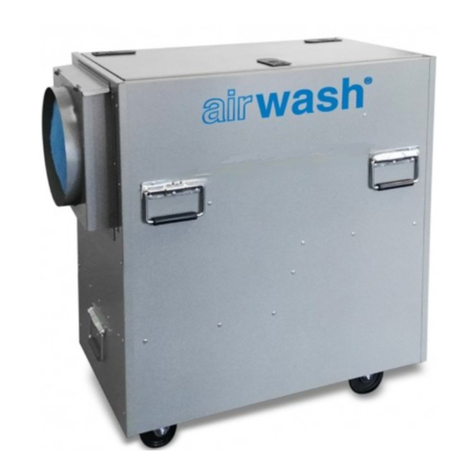
Amaircare
Amaircare Airwash MultiPRO BOSS AH2000 CART Operating and maintenance manual

Yosemite Home Decor
Yosemite Home Decor LINDSEY owner's manual
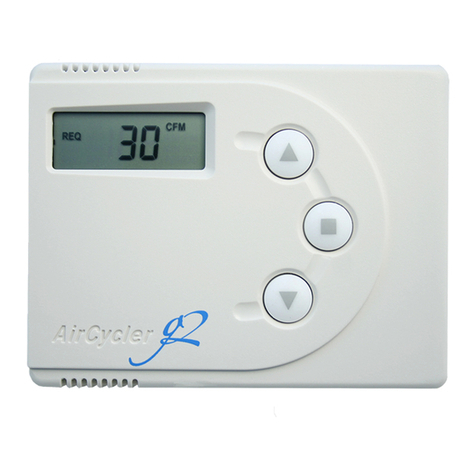
AirCycler
AirCycler g2 Installation & user guide
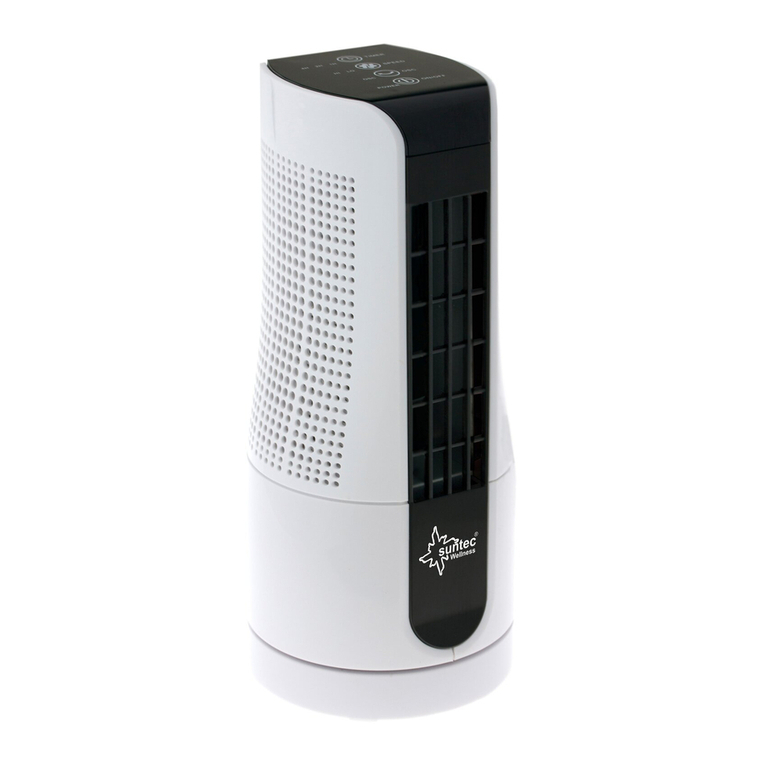
Suntec Wellness
Suntec Wellness Klimatronics CoolBreeze Sensation Desk+ manual
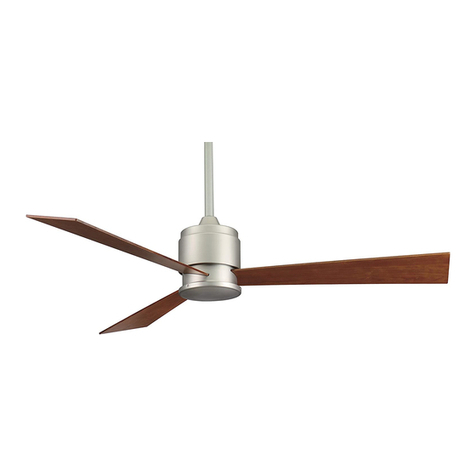
Fanimation
Fanimation The Zonix owner's manual
